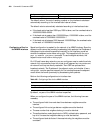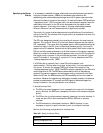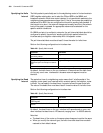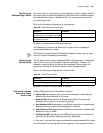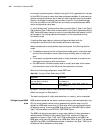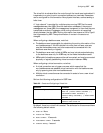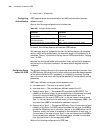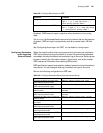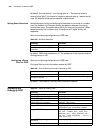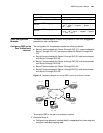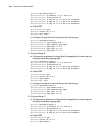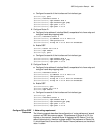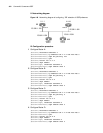
436 CHAPTER 29: CONFIGURING OSPF
■ dead-timer: 40 seconds
Configuring
Authentication
OSPF supports simple text authentication and MD5 authentication between
adjacent routers.
Perform the following configurations in interface view.
Table 502 Configure Authentication
By default, the interface does not authenticate OSPF packets.
The maximum length of a password for plain text authentication is 8 characters
and for a MD5 string authentication the maximum length of the password is 16
characters. The
key-id attribute is the key value of MD5 authentication, ranging
from 1 to 255.
Note that the configured packet authentication mode, authentication password,
and the key-id on the router interface in the same network segment must be
consistent.
Configuring Route
Import for OSPF
The dynamic routing protocols on the routers can share routing information. Due
to OSPF features, the routes found by other routing protocols are always regarded
as the routes outside the AS in processing. In the receiving command, the cost
type of the route, cost value, and flag can be specified to overlap default routing
parameters.
OSPF uses 4 different route types, whose sequence runs:
■ Intra-area route — The route in an area of the AS.
■ Inter-area route — The route between different areas of the AS.
■ External router Type 1— The received IGP route (such as RIP, STATIC). The
reliability of this route is high, so the calculated cost of the external route and
the cost of the route inside the AS are in the same numeric level. It is
comparable with the cost of OSPF route, i.e. the cost value of external route
Type 1 = the cost value from the local router to the corresponding ASBR + the
cost value from ASBR to the destination address of the route.
■ External router Type 2 — The received EGP route. Due to the concerns of poor
reliability of this route, the OSPF protocol considers the cost from the ASBR to
outside the AS as much as, or more than, the cost to the ASBR within the AS.
Therefore, mainly the former is considered in the calculation of route cost, i.e.
the cost value to the external route Type 2 = the cost values from the ASBR to
the route destination address. If the values are equal, consider the cost value
from the local router to the corresponding ASBR.
Perform the following configurations in OSPF view.
Operation Command
Specify a password for OSPF simple text
authentication
ospf authentication-mode simple
password
Specify the string and key-id for OSPF
MD5 authentication
ospf authentication-mode md5 string
key-id
Cancel authentication on the interface undo ospf authentication-mode



